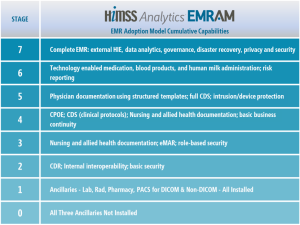This week, I participated in another HIMSS Analytics Acute Care EMRAM Stage 7 review team as the CIO reviewer. During the opening presentations by the organization’s leadership, I leaned over to the
full-time HIMSS reviewer to say, “They are hitting it out of the ballpark”. By the end of the day, our three-person review team had indeed reached that conclusion. The full-time reviewer said, “Some organizations barely clear the bar but this one far exceeded it.”
Only 6.1% of hospitals have achieved Stage 7. What does it take?
On review day, the review team is presented with information that includes a system overview, including governance, clinical and business intelligence, health information exchange, and plans for disaster recovery and business continuity.
The review team has been given a 17-page document that includes checklists for each major clinical area.
Several case studies are presented that demonstrate how the organization has used the system to improve clinical care.
The organization prepares for this visit for months, developing the case studies and verifying they have met every specific criterion. The full-time reviewer spends time on the phone reviewing their readiness.
Achieving Stage 7 takes teamwork throughout the organization to fully leverage all aspects of the vendor’s product. It takes engagement and passion from executives and clinicians.
The organization we were reviewing implemented their EMR according to these guiding principles:
Patient Centered: The primary goal of the project is to improve the patient experience and advance the quality of patient care
Clinical and Operational Ownership: Clinical and operational leadership will own the design of the EMR and drive the transformation effort
Enterprise Design: To capitalize on the benefits of an integrated system, the organization will strive to design a common model, based on the product’s foundation system
Easy to Use: The system will be designed to increase physician and clinician efficiency and ease-of-use, in both the hospital and the physician office setting
Best Practice: The organization will design towards best practice and evidence-based care
This organization has a hosting arrangement with their EMR vendor so they can concentrate on the application and its use rather than the infrastructure and operational support. This organization is also a Magnet hospital where nurses have had to demonstrate they use data to change clinical practice.
I could see and feel their commitment and success from the start of the day. Leaders of the organization each presented part of the overview, their case studies and answered our questions. And throughout the day I could see and feel it as we visited each area to interview managers and staff about their use of the system.
The CIO explained that the ‘go live’ was just the beginning. What matters was not getting the system implemented, but how they use the system.
The CIO is a forward thinker who is quick to recognize the entire team effort – and she is right to do so. However, I know from my experience that it takes strong, committed leadership from the CIO for this kind of success.
By the closing session, we could see that this healthcare organization had moved the EMR from an IT tool to a clinical tool. That says it all.
Kudos to this organization and all those who have achieved Stage 7. I would love to reveal the name of this organization and their CIO but I’ll let them crank up their own public relations machine when they are ready to hang with pride their Stage 7 banner.
For all of you aspiring Stage 7 organizations, continue to learn from those who have gone before you – the case studies from these organizations are available on the HIMSS Analytics website.
Resources and related posts:
HIMSS Analytics Resource Library Case Studies

Denis Tanguay on said:
Great post, thanks for sharing and look forward forward to reading future posts!
Denis Tanguay
Sue Schade on said:
Denis, thanks! Hope you will subscribe so you get notifications of new posts each week.
James Gaston on said:
Great observations Sue. The transition from IT driving the use of the EMR and technology to the operational and clinical leaders in the organization driving the use of the EMR and technology is a critical pivot point. It’s always satisfying to see ti done well as you witnessed at this organization….and witnessing first hand the betterment of care through information and technology.
Thanks for sharing your experience.
Sue Schade on said:
James, thanks for the feedback. Guessing you get to see a lot of organizations first hand.